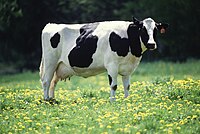
Photo from wikipedia
The objective of this narrative review was to compare the results of the 2015 Canadian National Dairy Study and the 2014 US National Animal Health Monitoring System (NAHMS) Dairy Studies,… Click to show full abstract
The objective of this narrative review was to compare the results of the 2015 Canadian National Dairy Study and the 2014 US National Animal Health Monitoring System (NAHMS) Dairy Studies, with a specific focus on calf management and welfare, and to interpret these findings within more recent calf health research to describe where we need to go next in the North American dairy industry. Situating results of periodic national studies within the context of past and recent research provides an opportunity to gauge adoption of recommendations and best practices and to help identify persistent and new challenges that the industry is wrestling with to help guide research needs. Through this review of the 2 national studies, we identified several strengths of the Canadian and US dairy industries. In each area of calf health management, improvements relative to previous NAHMS studies and the published literature have been found in the level of mortality, amount of colostrum fed, housing, and the number of producers using pain control for disbudding and dehorning. There were, however, some areas that present clear opportunities for improvement. Specifically, although mortality levels have improved, a large number of calves die at birth, within the first 48 h of life, and during the preweaning period. To improve the health of calves in early life, producers could look at feeding high-quality colostrum at 10% of body weight in the first feeding, as well as feeding a larger amount of milk during the preweaning period. The barriers to making these management changes and improving overall calf health need to be identified in future studies. The majority of preweaning calves in Canada and the United States are housed in individual housing. This represents a clear opportunity for improvement because recent research has identified the positive aspects of group housing. Finally, with respect to pain control, improvements are needed (particularly in the United States) to ensure that pain management is provided when disbudding and dehorning calves. Although the science is clear on pain management, discussions with producers are needed to identify reasons for the lack of uptake.
Journal Title: Journal of dairy science
Year Published: 2023
Link to full text (if available)
Share on Social Media: Sign Up to like & get
recommendations!